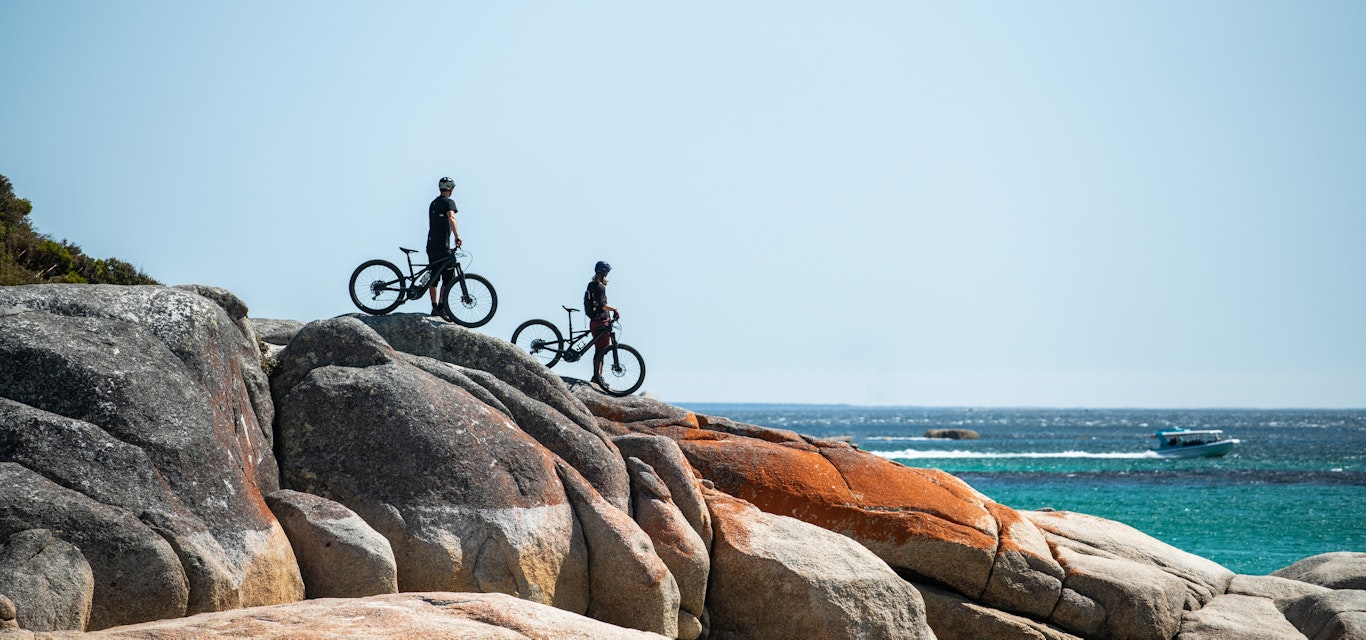Adventure Island
Sun’s out, fun’s in. Heat up an adventure in Tasmania this summer as the sun pours down onto trails, sea, rivers and mountains.
When the summer sun shines on Tasmania, adventures are cooking. Hiking and mountain-biking trails are at their best, coastal paths encourage swims, and rivers and seas beckon for kayaking, canyoning and rafting. There’s a warmth in the air, and a heat to the activities.
Splash into summer
It’s the time of year when the water calls loudest, presenting myriad kayaking opportunities. Setting out from Coles Bay, half-day Freycinet Adventures kayak trips cross to the shores of Freycinet National Park and quixotic Honeymoon Bay. Further south, it’s (rock) wall to (rock) wall drama on Roaring 40s Kayaking’s paddle out of Fortescue Bay to the rock stairs of Cape Hauy. Marine company includes fur seals and, on the best of days, whales, but mostly you’ll be looking high above water level to the 200m-high cliffs and the rock-climbing icons of the Totem Pole and Candlestick sea stacks.
Tasmania’s ultimate water adventure, once named the world’s best white-water trip by US adventure magazine Outside, is a rafting journey down the Franklin River. It’s committing, challenging and rewarding beyond measure, floating for more than a week through the Tasmanian Wilderness World Heritage Area, skirting Frenchmans Cap and ploughing through the Great Ravine, a deeply etched gorge crowded with furious rapids. Counterbalance this with the still-as-a-painting Irenabyss gorge and famed Rock Island Bend – scene of the Peter Dombrovskis photograph that helped rescue the Franklin from dams in the early 1980s – and it’s the complete river experience.
Less arduous, but no less fun, is a sledding trip on the Meander River, with half-day Meander Wilderness Experiences trips bouncing through small rapids atop a li-lo-like sled. Think of it as white-water rafting for one.
Credit: Kathryn Leahy
Credit: Lusy Productions
Credit: Lusy Productions
Beneath the surface
Leave the heat for the cooling challenge of Tasmania’s canyons and caves. Deep in the cracks that radiate through the earth beneath Cradle Mountain, canyoning trips provide a basement-level view of the alpine area.
In Dove Canyon, trips run by Cradle Mountain Canyons squeeze between rock walls, with canyoners leaping into cold, deep pools from 6m-high ledges and all but luging through the well-named Laundry Chute, a natural water slide carved beneath the cliffs by centuries of water flow. Families can head higher up the canyon, into the so-called Lost World Canyon, where the less-complex terrain makes trips suitable for kids over the age of eight. The further-flung Machinery Creek Canyon has a character all its own, with taller waterfalls and more open spaces making it a virtual stepladder of high abseils.
Delving even deeper into the earth, Tasmania is perforated with myriad caves. Gentle ranger-led tours operate through Hastings Caves in the south and King Solomons and Marakoopa caves around Mole Creek, but the real adventure begins beyond these show caves.
Mole Creek Karst National Park is punctured with around 300 caves, and Wild Cave Tours leads trips into little-known but feature-filled black holes, from the maze-like squeezes of Honeycomb Cave to caves with reflection pools beneath constellations of glow-worms.
Credit: Pierre DESTRIBATS
Credit: Stu Gibson
A wheely good time
Since Derby opened its first trails in 2015, Tasmania’s mountain-biking momentum has been relentless, with bike parks and trail networks sprouting like shoots across the state. Wherever you ride, the trails are at their firmest and best in summer. Sunny-season pleasures include St Helens’ Bay of Fires trail, plunging 42km from the top of the Blue Tier to the sands of Swimcart Beach (and a celebratory Bay of Fires swim), and the nearby Dreaming Pools, a 27km inland loop that passes a welcome swim-hole. Maydena provides the natural air-conditioning of a rainforest canopy along its 85-plus trails, and Derby’s lake is the cooling feature on a post-ride session at the Floating Sauna Lake Derby.
The long summer evenings also open up the possibility of after-work rides. For Hobart residents, this is now even more enticing with new trails opening on Kunanyi/Mt Wellington and the Clarence Mountain Bike Park. In 2023, the climbing Rocky Wheel’n and the descending Free Wheel’n opened on Kunanyi, while Clarence launched the well-named Flow Monster. All three trails are rated green (easy), making them accessible to most riders.
Credit: Jason Charles Hill
Foot traffic
Tasmania’s original outdoors passion was bushwalking, with a network of trails unsurpassed in Australia and most accessible and enjoyable through the warmth of summer. For mountain folk, the Overland Track wriggles between some of the state’s tallest and most spectacular mountains. Well-spaced huts divide the walk into a neat six days, with options to climb side peaks such as Cradle Mountain and Mt Ossa – Tasmania’s highest peak – along the way.
Coastal walks have a special appeal across summer, providing ready-made cooling at the end of – and during – long walking days. The South Coast Track connects nine beaches along Tasmania’s southernmost shores on its week-long journey from Melaleuca to Cockle Creek, and while the Three Capes Track might spend most of its four days atop Australia’s highest sea cliffs, it ends in prime swimming country on Fortescue Bay.
More instantly rewarding plunges come on day walks along the east coast such as Apsley Gorge or crossing the Hazards to the sands of Wineglass Bay.
